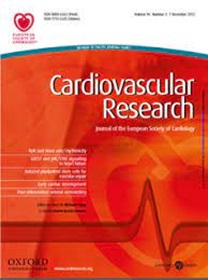定义啮齿动物HFpEF:一项系统综述。
IF 13.3
1区 医学
Q1 CARDIAC & CARDIOVASCULAR SYSTEMS
引用次数: 0
摘要
伴有保留射血分数(HFpEF)的心力衰竭(HF)已成为诊断最多的HF亚型,是一种主要的公共卫生负担,临床结果较差。HFpEF的可用治疗方案有限,因此需要更深入的基础/转化研究来确定新的治疗靶点。临床前研究经常依赖于HFpEF的小鼠和大鼠模型,但它们的表型准确性往往没有得到充分验证。在这里,我们探讨标记为“HFpEF”的啮齿动物模型在多大程度上反映了临床诊断指南。我们假设,许多基础/转化研究文章将“HFpEF”一词用于啮齿动物模型,尽管根据临床定义,它们表现出HFpEF体征和症状的程度可能有限。方法和结果利用PubMed数据库,我们确定了2008年至2023年间发表的N=475项使用HFpEF动物模型的研究。在排除非原创研究文章、使用小鼠或大鼠以外的动物物种的文章以及未声明标签为“HFpEF”的文章后,仍有N=407项研究被评估,总共有N=317个实验组被标记为“HFpEF”。基于来自欧洲心脏病学会心衰指南的预定义诊断集群,我们发现57%的实验组(N=179)提供了推荐的证据水平来支持使用“HFpEF”标签。较近的发表日期和较高的期刊影响因子与HFpEF概率呈正相关。尽管许多原创文章将小鼠和大鼠模型标记为“HFpEF”,但大约五分之二的研究未能提供足够的证据来支持这一说法。因此,在解释涉及啮齿动物HFpEF模型的研究的机制或介入性发现时,建议谨慎,在得出HFpEF的病理生理学或治疗结论之前,读者和审查员应彻底评估表型文件。本文章由计算机程序翻译,如有差异,请以英文原文为准。
Defining HFpEF in rodents: a systematic review.
AIMS
Heart failure (HF) with preserved ejection fraction (HFpEF) has become the most diagnosed HF subtype representing a major public health burden with poor clinical outcome. Available treatment options for HFpEF are limited, hence, more in-depth basic/translational research is needed to identify novel therapeutic targets. Preclinical investigations frequently rely on mice and rat models of HFpEF, yet their phenotypic accuracy is often not sufficiently verified. Here, we explore the extent to which rodent models labeled as 'HFpEF' reflect clinical diagnostic guidelines. We hypothesized that many basic/translational research articles use the term 'HFpEF' for rodent models, though the extent to which they demonstrate HFpEF signs and symptoms according to clinical definitions may be limited.
METHODS AND RESULTS
Using the PubMed database, we identified N=475 studies using animal models of HFpEF that were published between 2008 and 2023. After exclusion of non-original research articles, articles using animal species other than mice or rats, and articles which did not claim the label 'HFpEF', N=407 studies remained and were evaluated, featuring a total of N=317 experimental groups labeled as 'HFpEF'. Based on predefined diagnostic clusters derived from the HF guidelines of the European Society of Cardiology, we found that 57% of these experimental groups (N=179) presented with the recommended level of evidence to support the use of the label 'HFpEF'. More recent publication dates and higher journal impact factors were positively associated with HFpEF probability.
CONCLUSION
Despite many original articles labeling mouse and rat models as 'HFpEF', approximately two out of five studies fail to provide sufficient evidence to back this claim. Hence, caution is advised when interpreting mechanistic or interventional findings from studies involving rodent HFpEF models, and phenotypic documentation should be thoroughly assessed by readers and reviewers prior to drawing conclusions on the pathophysiology or treatment of HFpEF.
求助全文
通过发布文献求助,成功后即可免费获取论文全文。
去求助
来源期刊

Cardiovascular Research
医学-心血管系统
CiteScore
21.50
自引率
3.70%
发文量
547
审稿时长
1 months
期刊介绍:
Cardiovascular Research
Journal Overview:
International journal of the European Society of Cardiology
Focuses on basic and translational research in cardiology and cardiovascular biology
Aims to enhance insight into cardiovascular disease mechanisms and innovation prospects
Submission Criteria:
Welcomes papers covering molecular, sub-cellular, cellular, organ, and organism levels
Accepts clinical proof-of-concept and translational studies
Manuscripts expected to provide significant contribution to cardiovascular biology and diseases
 求助内容:
求助内容: 应助结果提醒方式:
应助结果提醒方式:


